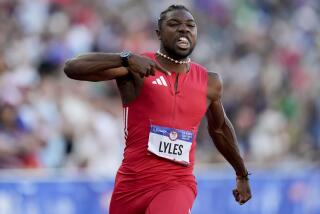Olympic Trap : Lakatos Has Put His Love of Racing on Hold for a Shot at the Games
- Share via
You would have to know Josh Lakatos to understand why he would try cramming his 6-foot, 170-pound frame into a micro-midget race car almost immediately after returning from a shooting competition in Seoul.
Lakatos, after all, is an Olympic prospect and a good one, having recently returned from a gold-medal performance with his shotgun, winning the trap competition in the Seoul World Cup. Three weeks before that he had shattered the men’s world record by hitting 120 of 125 clay targets and 24 of 25 in a sudden-death shoot-off for the gold medal at the Cairo World Cup in Egypt.
Lakatos, 20, the youngest member of the U.S. national shooting team, is quickly establishing himself as one of the world’s premiere shooters. And he is intent on winning a gold medal in the 1996 Olympic Games at Atlanta.
But despite this determination to become the best in the world with a shotgun, Lakatos will be the first to tell you that he would rather be sliding around a track in a 300-horsepower midget racer, or any other open-wheel car for that matter.
“When this is over, after ‘96, I will go back to racing,” said Lakatos, a Pasadena-born athlete in residence at the Olympic training center in Colorado Springs. He returned home this week with the U.S. national shooting team that is competing in the World Cup USA at the Prado-Tiro ranges in Chino.
So, said his father, Steve, he and Bobby Olivero, former Indy and midget racer, have put Lakatos’ racing career on hold until after the Olympics.
“He’d jump into a race car right now if he had a ride,” Steve Lakatos said.
Josh nearly had that ride. After being told by U.S. shotgun Coach Lloyd Woodhouse that he would not be competing in this week’s World Cup “because the jet-lag (from his recent trip to Seoul) would just be too much,” Lakatos drove to a track in Perris and talked an old friend into letting him drive.
But he couldn’t, because he didn’t fit into the car.
“The way the car was built, the (steering) wheel was too far up and my legs were too long,” he said with a sigh of frustration.
All this is understandable, considering Lakatos’ upbringing.
Lakatos practically lived at Ascot Park Raceway in his formative years.
“As soon as they could get me out of the hospital (as a newborn) I was at Ascot,” he said. “We just went out there every weekend, for seven years.”
There and elsewhere on the midget circuit. Lakatos couldn’t get enough, hanging out with his father, who worked in Olivero’s crew. And Olivero was like a second father to young Lakatos.
“I always wanted to be like him and always wanted to drive,” Lakatos said. “Every time a race was over, I’d go sit in the car and pretend to drive when they would push it into the trailer.”
He got his chance to drive when he was 8, behind the wheel of a quarter-midget. Lakatos excelled, eventually winning several state titles before winning a national title when he was 13.
But a growing Lakatos had outgrown the scaled-down version of an already small car. And his father couldn’t afford a full midget.
“I was just too big for quarter-midgets and figured, ‘Let’s go do something new for a while,’ ” Lakatos said.
Enter the world of trapshooting, which involves hitting clay disks as they fly from underground bunkers at speeds up to 65 m.p.h. Steve Lakatos had been a member of the San Gabriel Valley Gun Club and Josh became part of its junior program.
He had a knack for hitting the clay birds and local experts suggested to his father that he develop that knack.
And because Lakatos had little interest in his high school work at Don Bosco Technical Institute, his father chose to use the shotgun as sort of an incentive.
“He told me, ‘You pass, and you can shoot,’ ” said Lakatos, who barely passed.
But boy, did he shoot.
He went to a shooting camp in Connecticut, where instructors were impressed enough to suggest more expert training. Lakatos was introduced to Dan Carlisle, Olympic bronze medalist and former world champion, and there was no turning back.
“After the first lesson, Danny says to me, ‘This kid definitely has the greatest eyes I’ve ever seen,’ and said ‘I’d like to take this kid to the Olympics,’ ” Steve Lakatos recalled.
The word Olympics was all it took for the older Lakatos to really indulge his son. He shelled out the money and Josh, under the guidance of Carlisle, shot hundreds of shotgun shells three days every week.
He became California state trap champion in 1989 and again in ’91.
He won two silver medals at the 1991 National Junior Olympics and the gold at the 1991 U.S. Olympic Festival. But still, he could not get his mind off racing.
“After I got into shooting, I would go to races and watch and it was great, but unless I was working on a car, I couldn’t sit in the stands and watch because I know I could be out there,” Lakatos said. “And sometimes I would think, ‘If I wasn’t doing this stupid sport, I could be out there racing.’ ”
When it came time to qualify for the 1992 Olympics, Lakatos figured on making the team and going as far as he could. His father would be proud, he could then scale back his competitive shooting and concentrate on racing.
Instead, he was dealt a heavy dose of reality. He shot poorly at the Olympic trials and didn’t qualify.
And when, seeking consolation, he called home to talk to his father, he learned that on that same day, his good friend, Kara Hendrick, had been killed in a midget car race in San Diego.
“I was ripped up for about three or four weeks,” Lakatos said. “A lot of people quit racing after that. A lot of people never want to see me in a car again because of that.”
Woodhouse says Lakatos is training harder than ever in his endeavor to make the ’96 Olympics not only in trap and doubles--two targets are released simultaneously--but in skeetshooting as well, a variation of trap. Few shooters excel at both trap and skeet.
With Hendrick’s name and racing number inscribed on his guns, Lakatos, in his first event this year at Cairo, shot well enough to qualify for the Olympic trials in each event.
“He shot the (minimum qualifying scores) in trap, double trap and skeet and now is qualified in all three shooting events,” Woodhouse says. “Athletes can achieve that at any time before the Olympics and some usually take three or four tries. He did it first time out.
“He wants it bad. He just wants it bad. And that’s the one thing no one can instill in a person: the internal self-motivation, that burning desire to achieve.”
And to think he is willing to put all of this behind him, to leave it in the dust, so to speak, preferably behind the wheel of a midget racer.
More to Read
Go beyond the scoreboard
Get the latest on L.A.'s teams in the daily Sports Report newsletter.
You may occasionally receive promotional content from the Los Angeles Times.






